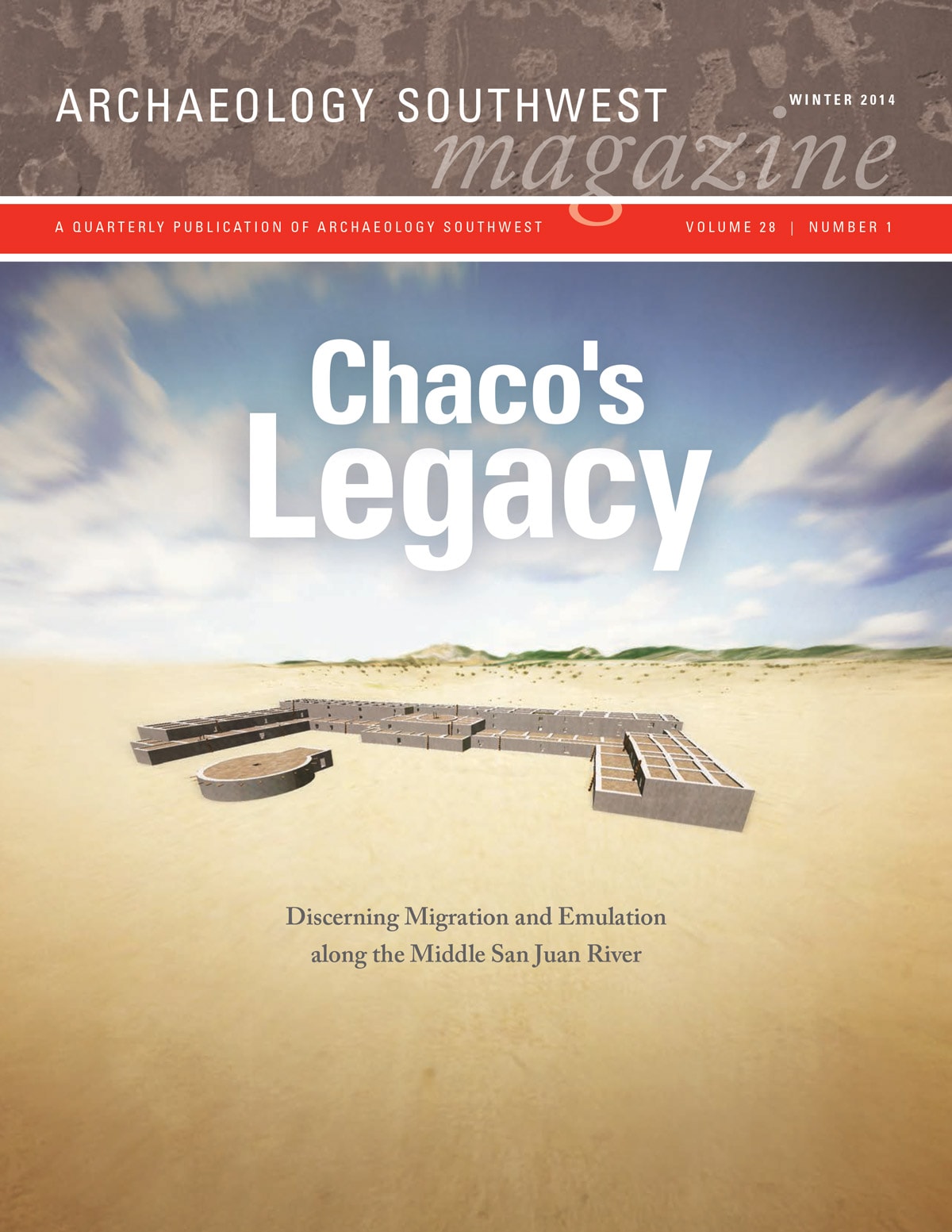Chaco’s Legacy
Archaeology Southwest Magazine Vol. 28, No. 1
Issue editor: Paul F. Reed, Archaeology Southwest and Chaco Scholar at Salmon Ruins
On behalf of Archaeology Southwest, and with funding from the National Science Foundation (NSF), Paul Reed led the Chaco Migration or Emulation project. The research team sought to determine whether great houses in the MSJ represent migration or emulation. In other words, did Chacoans (people from the canyon) move north and build these great houses for themselves, or for themselves and local groups? Did local people build them for leaders who wished to join the Chacoan network? Are some great houses a result of migration and others a result of emulation? And why are these important questions?
Chaco’s Legacy: Discerning Migration and Emulation along the Middle San Juan River — Paul F. Reed
For further reading:
Reed, Paul F.
2011 Chacoan Immigration or Emulation of the Chacoan System? The Emergence of Aztec, Salmon, and Other Great house Communities in the Middle San Juan. Kiva 77(2):119–138.
In Brief: Salmon and Aztec — Paul F. Reed
Salmon Ruins Museum, Library, and Research Center
Aztec Ruins National Monument
Archaeology Southwest Magazine Vol. 20, No. 3 — Salmon Pueblo: Chacoan Outlier and Thirteenth-Century Middle San Juan Community Center (opens as a PDF)
Archaeology Southwest Magazine Vol. 16, No. 2 — Salmon Ruins: Past Present, and Future (opens as a PDF)
For further reading:
Reed, Paul F. (editor)
2006 Thirty-Five Years of Archaeological Research at Salmon Ruins, New Mexico, 3 vols. Center for Desert Archaeology, Tucson, and Salmon Ruins Museum, Bloomfield, New Mexico.
2008 Chaco’s Northern Prodigies: Salmon Aztec, and the Ascendancy of the Middle San Juan Region after AD 1100. University of Utah Press, Salt Lake City.
In Brief: What Was It about Chaco? — Paul F. Reed
Chaco Culture National Historical Park
Scholars have shared a variety of viewpoints on Chaco at several Archaeology Southwest events:
Watch Paul Reed’s 2010 Archaeology Café presentation, The Complexity and Diversity of Chaco Canyon
Watch Ruth Van Dyke’s 2011 Archaeology Café presentation, The Chaco Experience
Watch Steve Lekson’s 2013 Archaeology Café presentation, What Was Chaco, Really?
Watch Gwinn Vivian’s Tea & Archaeology presentation, Living in Chaco, Interpreting Chaco
Investigating Ritual Wooden Artifacts from Aztec West — Laurie D. Webster
For further reading:
Webster, Laurie D.
2011 Perishable Ritual Artifacts at the West Ruin of Aztec, New Mexico: Evidence for a Chacoan Migration. Kiva 77(2):139–171.
Identifying Local and Immigrant Potters in the Middle San Juan — Lori Stephens Reed
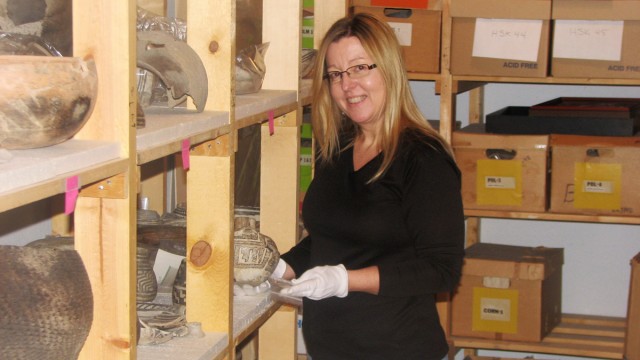
Lori Stephens Reed examines the collections at Salmon Ruins Museum.
Lori writes: Using existing museum collections to address research questions that would otherwise require excavation is a key strategy of Preservation Archaeology, and one that my recent research has embraced. The collection at Salmon Ruins, which you see me examining here, includes an enormous number of potsherds and whole pots, as well as substantial amounts of pottery from the surfaces of sites in the Middle San Juan region. Earl Morris’s excavations at Aztec Ruins yielded a vast collection that is stored primarily at the American Museum of Natural History. A smaller segment of this collection is currently at Aztec Ruins National Monument. Through a $175,000 grant award from the Save America’s Treasures program, Salmon Ruins has been able to rehouse its collections in a specially built facility.
For further reading:
Washburn, Dorothy K., and Lori Stephens Reed
2011 A Design and Technological Study of Hatched Ceramics: Tracking Chacoan Migrants in the Middle San Juan. Kiva 77(2):173–201. (See references to Hayward Franklin’s work on page 197 of this article.)
Documenting Great House Architecture at Aztec Ruins — Gary M. Brown
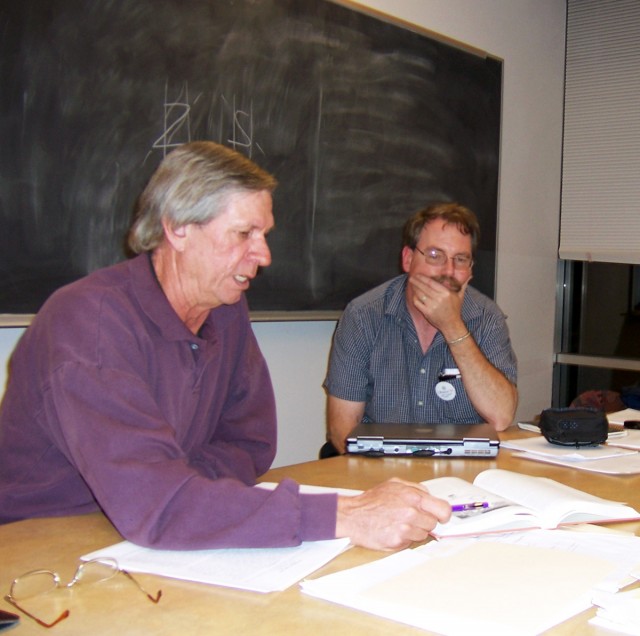
Gary and Paul working on the Chaco Migration or Emulation project.
Gary notes: Paul Reed (right) and I discussing the Chaco Migration or Emulation project. Since excavation by the American Museum of Natural History almost a century ago, the National Park Service has maintained standing remnants of the multistory great houses at Aztec Ruins and tried to interpret these Chaco-style structures. Over the last twenty years, preservation has shifted from reconstruction and traditional ruins stabilization to backfilling. The decision to rebury fragile architecture stimulated research to collect data the original excavators had not gathered, and which would subsequently be hidden from view. As head of this research program, I spent more than a decade recording architectural details, supervising various experts, and devising ways to fill many of the largest and deepest structures at West Ruin, the largest great house at Aztec and the scene of most excavation.
For further reading:
Brown, Gary M., and Cheryl I. Paddock
2011 Chacoan and Vernacular Architecture at Aztec Ruins: Putting Chaco in Its Place. Kiva 77(2):203–224.
In Brief: Building Sequences at Aztec — Gary M. Brown
Aztec Ruins National Monument
Finding Chacoan Immigrants and Seeking Emulation on the Middle San Juan Landscape — Paul F. Reed
For further reading:
Reed, Paul F.
2011 Middle San Juan Settlement Patterns: Searching for Chacoan Immigrants and Evidence of Local Emulation on the Landscape. Kiva 77(2):225–249.
Appraising Chaco’s Legacy in the Middle San Juan — Jeffery J. Clark and Paul F. Reed
For further reading:
Clark, Jeffery J., and Paul F. Reed
2011 Chacoan Immigration and Influence in the Middle San Juan. Kiva 77(2):251–274.
Tales Teeth Tell — Paul F. Reed
Dental analysis is a component of bioarchaeology, the study of human remains from archaeological contexts. Examination of teeth helps archaeologists understand life history and ancestry. Comparison of specific heritable features on a tooth’s surface and subtle differences in shapes and grooves allow researchers to estimate relatedness between two groups of people.
In 2010, Kathy Durand Gore and her colleagues published a study of dental traits that sought to determine relatedness among Pueblo people in the Middle San Juan and Chaco Canyon. Samples came from small pueblo and great house sites. Their results indicate a close relationship between people at Pueblo Bonito and people at Aztec West. The Salmon Pueblo samples came from the period after most people of Chacoan heritage had left the pueblo, when local groups began transforming the great house. Not surprisingly, this later Salmon sample set grouped mostly closely with sites in the La Plata River valley, but it also showed some affinity with the larger group of Aztec and Pueblo Bonito. Small sites in the lower San Juan and La Plata valleys grouped closely, suggesting a close affinity between these locally derived populations. Overall, these findings accord well with the results of our Chaco Migration or Emulation project.
For further reading:
Durand, Kathy Roler, Meradeth Snow, David Glenn Smith, and Stephen R. Durand
2010 Discrete Dental Trait Evidence of Migration Patterns in the Northern Southwest. In Human Variation in the Americas: The Integration of Archaeology and Biological Anthropology, edited by B. M. Auerbach. Occasional Paper 38, Center for Archaeological Investigations, Southern Illinois University, Carbondale.
Sharing Chaco’s Legacy — Douglas W. Gann
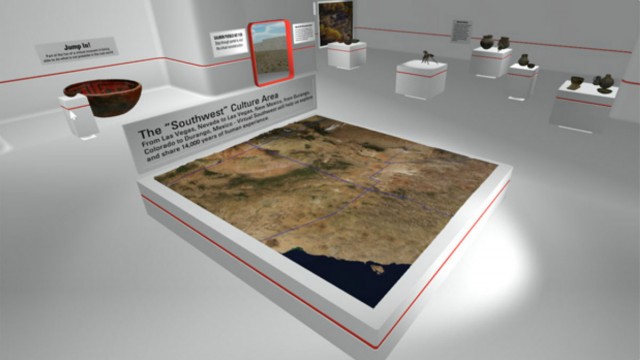
The original interface of Virtual Southwest.
Virtual Southwest experience
Chaco’s Legacy project page
CVR project page
Read Doug’s blog post on how he and Adriel Heisey collaborated to re-create the Chacoan landscape.
In Brief: Renovating Exhibits at Aztec Ruins National Monument — Tracy Bodnar and Lauren Blacik
Aztec Ruins National Monument
Zuni View of Chaco’s Legacy — Dan Simplicio, Cultural Consultant, Zuni, New Mexico
Pueblo of Zuni
Earl Morris: Local Boy Done Good — Kate Sarther Gann
Information about Morris was drawn from the following sources:
Lister, Florence C., and Robert H. Lister
1968 Earl Morris & Southwestern Archaeology. The University of New Mexico Press, Albuquerque.
Lister, Robert H., and Florence C. Lister
1969 The Earl H. Morris Memorial Pottery Collection. University of Colorado Studies Series in Anthropology No. 16. University of Colorado Press, Boulder.
Morris, Ann Axtell
1933 Digging in the Southwest. Cadmus Books, E. M. Hale and Co., Chicago.
University of Colorado Museum
1985 Among Ancient Ruins: The Legacy of Earl H. Morris. Introduction by Joe Ben Wheat. Johnson Books, Boulder.
In Brief: Cynthia Irwin-Williams — Paul F. Reed
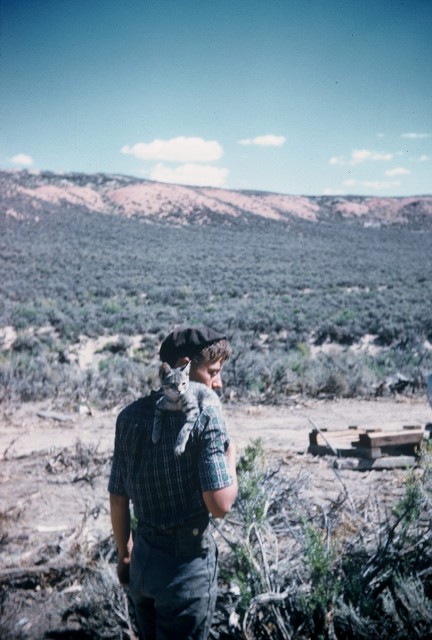
Cynthia Irwin-Williams at the U.P. Mammoth site in Wyoming. Photo courtesy of Fred Nials.
The Inspiring Life of Cynthia Irwin-Williams, a video produced by Eastern New Mexico University’s Anthropology Department and Mu Alpha Nu Anthropology Club (opens in YouTube)
Lynn Teague’s essay “Cynthia Irwin-Williams: A Profile” is on page 5 of Archaeology Southwest Magazine Vol. 16, No. 2 (opens as a PDF). Teague wrote a longer tribute for Kiva 56(1):87–91.
Back Sight — William H. Doelle
Subscribe
